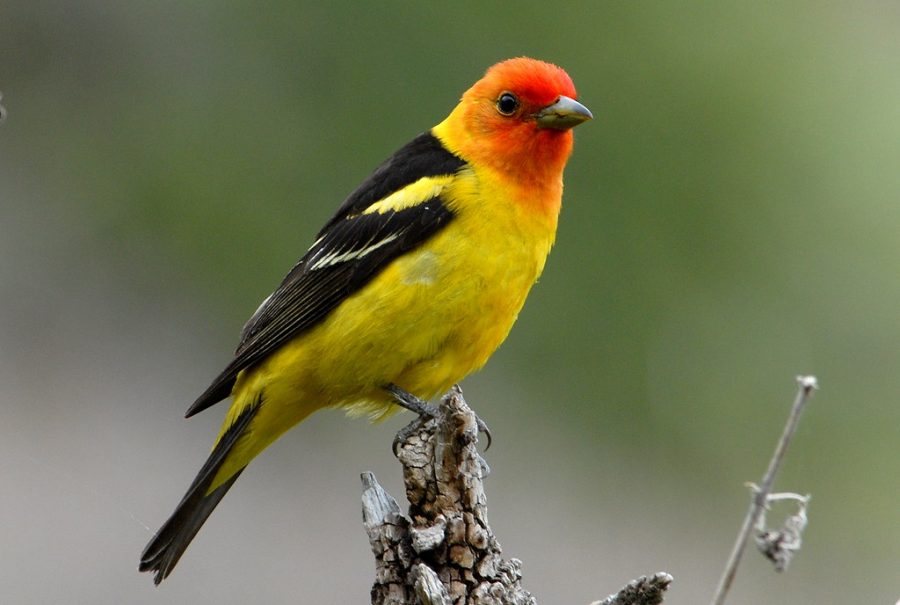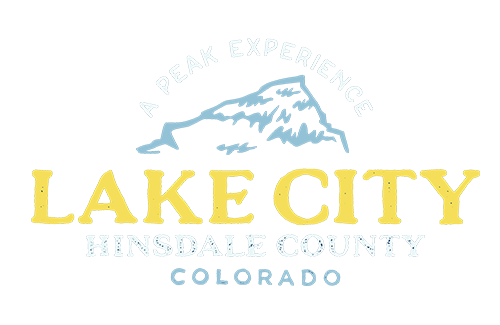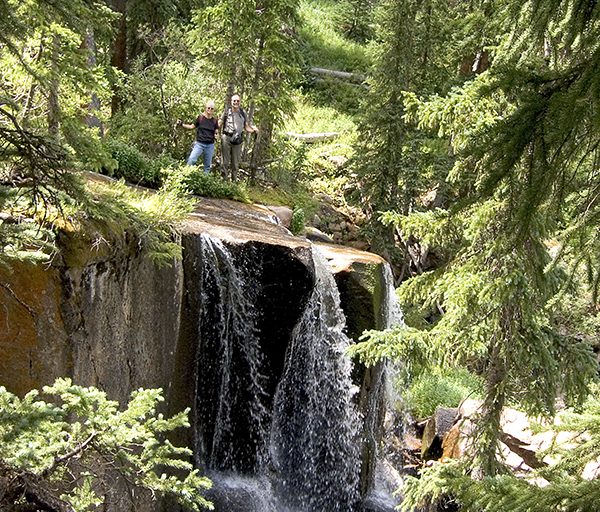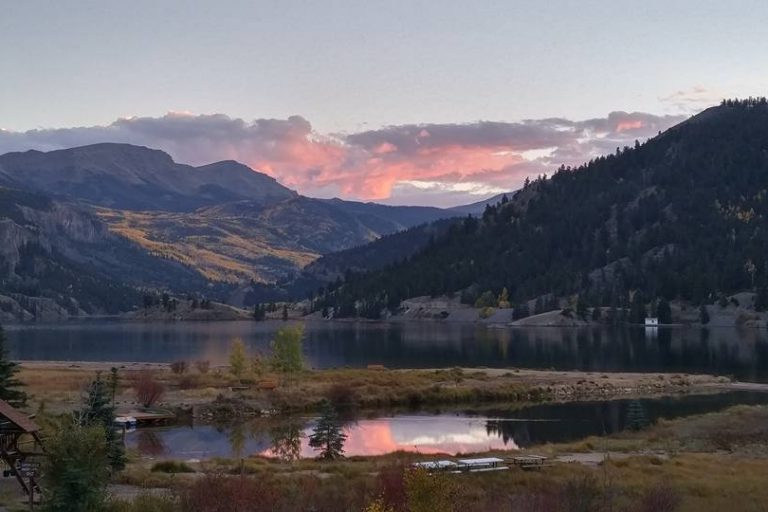Wildlife and Birds

Wildlife and Birds
Remote, sparsely populated, blessed with high mountain lakes, streams, forests, and hideaways that provide ever-nurturing habitats.
Hinsdale County is both the year-round and migratory home of choice to a myriad of flora and fauna that grace its landscape. From the lumbering moose to the tiny pika, from the bright Western Tanager to the “fisherman” Osprey — in-town and away-from-it-all — “surprise” wildlife sightings are abundant.
A wide variety of mammals live in or migrate through the magnificent San Juans. Frequently seen are deer, which often wander throughout town, and elk herds that graze just north of Lake City in the winter. Rabbits and coyotes are known to live in and around the town limits and are often seen on the Silver Thread Scenic Byway.
After an introduction to the area by Colorado Parks and Wildlife in the early 1990s, moose are now thriving occupants of the San Juans and Hinsdale County. These solitary creatures are known to take cover in willows and the brushy area on the south side of Lake San Cristobal and up at Deer Lakes. The lynx, a member of the cat family, was reintroduced to the area and is not often spotted around Lake City because they prefer dense spruce and fir forests. Other animals in the area include pikas, black bears, marmots, chipmunks, and squirrels.
Lake City Wildlife
Moose
Moose were introduced into this area in the winter of 1990-91. Since then the population has grown and spread out to a wide area. Moose are the largest member of the deer family. They browse on willows and aquatic plants so are usually found near water. Bulls have heavy palmate antlers that are shed each winter. Calves are reddish in color and have very long legs.
Golden Mantled Ground Squirrel
This common little guy is the chunky feller begging at any area tourists stop with their lunch. He is an excellent beggar although it does not do him good because his system is not designed to eat human snacks. Notice he does not have a line going through his eye. That is the easy way to tell he is not a chipmunk.
Chipmunk
The chipmunk begs also but is slimmer and lighter. He has a line of color that continues from his tail and body and goes through his eye to the end of his nose. The line is the easy way to tell it is a chipmunk.
Mule Deer
Male deer or bucks have antlers that are shed every winter and new ones are grown each spring. Their antlers are unlike white-tailed deer because they are diverticular, that is dividing in two at each junction. Young fawns are spotted to give them camouflage from predators.
Pika
This short-eared rabbit (actually a hare) lives in rock piles usually above timberline. They are also known as the little haymakers because of the way they cut and dry “hay” and then stack it in crevices in the rock for use during the winter.
Beaver
Beaver are large aquatic rodents that build dams in streams. They build caches to feed in the winter and lodges to live in. Lodges have underwater entrances. Beaver can also tunnel back into stream banks. They cut aspen and willow to build dams, construct lodges and to eat. Because of their habits of cutting trees and damming irrigation ditches, beaver can earn a bad neighbor reputation but they contribute to a healthy environment by raising the water table and widening the riparian zone. Beaver have wide flat tails and “slap” the water when there is danger near.
Rocky Mountain Elk
Elk are much larger than deer. Males or bulls shed antlers each winter and regrow them in the spring. In the spring and summer, the antlers are covered with a “velvet” or fuzzy covering. Females are known as cows. Young calves are spotted to protect them from predators.
Mountain Cottontail
The mountain cottontail is a true rabbit. It is much smaller than jackrabbits. It does not change color in the winter. It has relatively short ears.
Snowshoe Hare
The favorite food of the lynx is the snowshoe hare. It is white in the winter and brown in the summer. It has very large hind feet.
Marmot
Marmots are also found near rocks and often have a den underneath rocks. They vary in color from tan (even some white ones) to dark brown. They are chunky with a big thick tail that rolls ponderously behind them.
Big Horn Sheep
Males or rams have heavy horns that grow in a circular pattern throughout their life. You can tell the age of an animal by counting the heavy rings. Horns are never shed. Females or ewes have thinner horns that grow in a slight curve to the rear. Their young are called lambs. Sheep live in areas near rocky cliffs and that is what they use for escape routes.
For those who prefer to watch the winged species of our area, know there are plenty of birds to observe. The most common birds in the Lake City area include stellar jays and chickadees that are seen year round. Seasonal residents include western tanagers, Cassin’s finch, American goldfinch, evening grosbeaks, black-headed grosbeaks, and two common types of hummingbirds: broad-tailed and rufous hummers. A wonderful spot in town for bird watching is Pete’s Lake, which has a walking trail. Warblers, other songbirds, and numerous waterfowl are known to spend time at Lake San Cristobal.
Lake City Birds
Osprey
Know also as the fish eagle, osprey are almost always located near water. They make spectacular dives, feet first, for fish, sometimes going completely under the water. Some sources indicate fish, 2 pounds and larger, make up 98% of this bird’s diet.
Mountain Bluebird
Have you noticed the many bird boxes that are on the fences along the highways in this area? Bluebirds had almost disappeared from the area years earlier because of the lack of suitable nesting sites. Cavity nesters need trees with holes and firewood cutters had taken down most of the old dead trees. Because of the bluebird boxes, the mountain bluebird has returned to its habitat.
Broad-tailed Hummingbird
This tiny bird migrates from Guatemala to this area annually. It is the common nesting hummer that spends the summer here. A female, banded in Colorado, was the oldest known hummingbird at 12 years of age. Easterners will often mistake this species for the ruby-throated that inhabits the eastern areas of the United States.
Rufous Hummingbird
This feisty, rust-colored hummer often stops in Lake City on its return migration to south-central Mexico and the gulf coast. This tiny bird goes to the Pacific Northwest (southern Alaska) to nest and raise its young. They migrate up the Pacific Flyway, mostly through the California area. Rufous usually arrive in the Lake City area around the Fourth of July and move on by the first part of August. Males fiercely defend feeders from other hummers, including the broad-tails.
Mountain Chickadee
Both the Mountain and the Black-capped Chickadee inhabit this area. Mountain chickadees have a black line through the face like a little bandit whereas the black-capped does not. Chickadees are fearless and are willing to take sunflower seeds out of your hand if you have a little patience and are quiet and still. Chickadees are “name-sayers” since one of their calls is “chick-a-dee-dee-dee” or “Fee-bee-bee”. Listen for them in the forest.
Stellar Jay
The large, brilliant blue bird, with the topknot, or crest, common in the Lake City area is the noisy stellar jay. They are not Bluejays, which are not found in the west. The Stellar is a close cousin to the camp robber or grayjay but is a little more reserved.
Western Tanager
The bright yellow and red bird with the black wings is the male western tanager. Looking almost out of place, it is the only neotropical bird that migrates to this area. The females are a dull yellow – likely Nature’s way of protecting the nest. The females spend a significant amount of time incubating and their drabber color is less obvious to predators.
Black-headed Grosbeak
Both black-headed and evening grosbeaks spend time around Lake City in the summer. An occasional red-breasted grosbeak will also show up. Grosbeaks are so named because of their heavy beak. The beak is a clue as to the diet of birds. Heavy beaks are typically used to crush seeds.
American Goldfinch
The small, lemon yellow male goldfinch is one of the few birds that molts, or changes feathers, twice a year. Often incorrectly called wild canaries, American goldfinch travel in small flocks, and their unique call sounds a lot like po-ta-to chip. They are distinguished from other “wild canaries” (small yellow birds) by their black wings.
Rosy Finch
Rosy finches are only found in the Rocky Mountains. This uniquely-adapted bird nests above timberline on the ground or in rocks. In winter, the large flocks will sometimes come to area bird feeders in the hundreds or even thousands. One rosy finch photographed in Lake City had been “banded” as an adult the winter before in Crested Butte.
Junco
Often called “snowbirds” by locals, juncos generally show up when autumn snows begin. They prefer eating on the ground to perching on a feeder. Unfortunately, this makes them very susceptible to domestic cats.
Dusky Grouse
Called blue grouse up until the last few years, this local grouse inhabits the spruce-fir forests in the west. The solitary male struts in the spring to attract females on traditional leks or breeding grounds. They are not the Gunnison Sage grouse, a threatened species that inhabits sagebrush areas closer to Gunnison.
American Kestrel
Kestrels are the smallest falcon and also the most common. Often seen perched on an electric wire, they are constantly watching for large insects, such as dragonflies, crickets, and grasshoppers. They will also feed on small birds and some amphibians.







